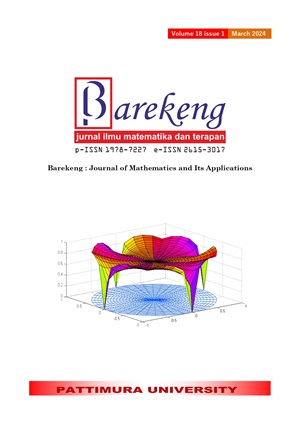MODELING THE MANY EARTHQUAKES IN SUMATRA USING POISSON HIDDEN MARKOV MODELS AND EXPECTATION MAXIMIZATION ALGORITHM
Abstract
Sumatra Island is one of the islands that are prone to earthquakes because Sumatra Island is located at the confluence of three plates, namely the large Indo-Australian plate, the Eurasian plate and the Philippine plate. In general, the number of earthquake events follows the Poisson distribution, but there are cases where there is overdispersion in the Poisson distribution. The Poisson Hidden Markov Models (PHMMs) method is used to overcome overdispersion, then applying the Expectation-Maximization Algorithm (EM algorithm) to each model to obtain the estimated parameters. From the models obtained, the best model will be selected based on the smallest Akaike Information Criterion (AIC) value. The data used is secondary data on earthquake events on the island of Sumatra from January 2000 to December 2022 with a depth of ≤ 70 Km and a magnitude of ≥ 4.4 Mw. From the research, the model with m = 3 is the best estimation model with an AIC value of 1503,286. From the best model, estimates are obtained for Poisson Hidden Markov Models with an average occurrence of earthquakes of 5.7633 ≈ 6 events within one month.
Downloads
References
S. Mutiah, H. Pratiwi, and S. Handajani, “Penerapan Model Epidemic Type Aftershock Sequence (ETAS) pada Data Gempa Bumi Sulawesi dan Jawa,” Prosiding-M28, 2019.
M. A. Alwansyah, N. Hidayat, D. I. Fadli, D. S. Rini, and P. Jana, “Spatial zone analysis of earthquake in Sumatra,” Proceeding 7Th Int. Conf. Sci. Technol. Interdiscip. Res. (Ic-Star 2021), vol. 2601, p. 020009, 2023.
R. Metrikasari and A. Choiruddin, “Pemodelan Risiko Gempa Bumi di Pulau Sumatera Menggunakan Model Inhomogeneous Neyman-Scott Cox Process,” J. Sains dan Seni ITS, vol. 9, no. 2, 2021.
R. Suryandaru, “Estimasi Model Terbaik Banyaknya Gempa Bumi Menggunakan Poisson Hidden Markov Models Dan Algoritma EM,” Universitas Islam Negeri Syarif Hidayatullah Jakarta, 2015.
H. M.Taylor and S. Karlin, Introduction to Stochastic Modeling. 2011. doi: 10.1201/b11089-8.
Y. Widyaningsih, G. P. Arum, and K. Prawira, “Aplikasi K-Fold Cross Validation Dalam Penentuan Model Regresi Binomial Negatif Terbaik,” BAREKENG J. Ilmu Mat. dan Terap., vol. 15, no. 2, pp. 315–322, 2021.
S. J. Long, Regression Models for Categorical and Limited Dependent Variables. California: International Education and Professional Publisher, 1997.
M. Abdy, W. Sanusi, and R. Rahmawati, “Aplikasi Model Rantai Markov Untuk Menganalisis Tingkat Kenyamanan Di Kota Majene Berdasarkan Temperature Humidity Index (Thi),” BAREKENG J. Ilmu Mat. dan Terap., vol. 15, no. 1, pp. 009–014, 2021.
V. Koerniawan, N. Sunusi, and Raupong, “Estimasi Parameter Model Poisson Hidden Markov Pada Data Banyaknya Kedatangan Klaim Asuransi Jiwa,” vol. 1, no. 2, pp. 65–73, 2020.
I. I. Pertiwi, “Analisis Statistik Distribusi Kejadian Gempabumi Di Luwu Timur, Morowali, dan Morowali Utara, Sulawesi,” J. Geofis., vol. 20, no. 01, pp. 1–7, 2022.
G. R. Grimmett and D. R. Stirzaker, Probability and Random Processes, Fourth Edit. Oxford University Press, 2020.
V. Capasso and D. Bakstein, An Introdusction to Continuousi-Time Stochastic Processes, Fourth Edi. Birkhauser, 2021.
Y. A. Pradana, D. A. Azka, A. C. Aji, and I. M. Fauzi, “Analysis of Weather Changes for Estimation of Shallot Crops Fluctuation Using Hidden Markov,” BAREKENG J. Ilmu Mat. dan Terap., vol. 16, no. 1, pp. 333–342, 2022.
W. Zucchini, I. L. MacDonald and R. Langrock, Hidden Markov Models for Time Series, Second Edit. London: CRC Press, 2016.
A. Irawan, “Implementasi Poisson Hidden Markov Models & Expectation Maximization Algorithm Untuk Estimasi Kejadian Gempa Bumi Di Indonesia,” Universitas Islam Indonesia, 2021.
Irina Hidayati, “Implementasi Poisson Hidden Markov Models Dan Expectation Maximization Algorithm Dalam Penentuan Model Terbaik,” Universitas Islam Indonesia, 2018.
M. Irsyam et al., Peta Sumber dan Bahaya Gempa Indonesia Tahun 2017, First edit. Kementrian Pekerjaan Umum dan Perumahan Rakyat, 2017.
Copyright (c) 2024 Muhammad Arib Alwansyah, Ramya Rachmawati

This work is licensed under a Creative Commons Attribution-ShareAlike 4.0 International License.
Authors who publish with this Journal agree to the following terms:
- Author retain copyright and grant the journal right of first publication with the work simultaneously licensed under a creative commons attribution license that allow others to share the work within an acknowledgement of the work’s authorship and initial publication of this journal.
- Authors are able to enter into separate, additional contractual arrangement for the non-exclusive distribution of the journal’s published version of the work (e.g. acknowledgement of its initial publication in this journal).
- Authors are permitted and encouraged to post their work online (e.g. in institutional repositories or on their websites) prior to and during the submission process, as it can lead to productive exchanges, as well as earlier and greater citation of published works.






1.gif)



